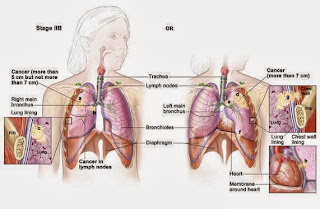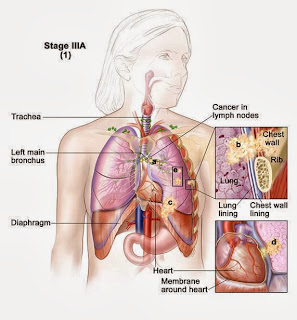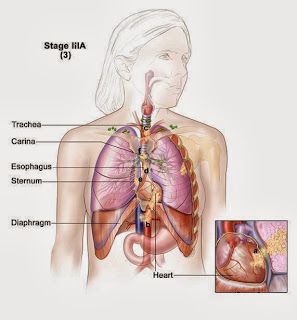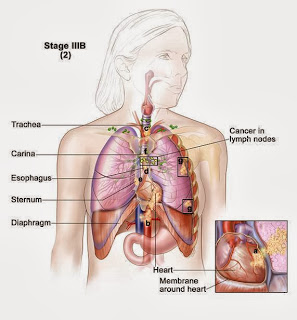The accompanying stages are utilized for non-Small Cell lung cancer:
As you know we are discussing types of most common cancer and lungs with cancer is one of most common cancer type. Here we briefly describe the treatment of non-small cell lung cancer of different stages.
Mysterious (covered up) stage
In the mysterious (covered up) stage, tumor can't be seen by
imaging or bronchoscopy. Disease cells are discovered in sputum (bodily fluid
hacked up from the lungs) or bronchial washing (a specimen of units taken from
inside the aviation routes that accelerate the lung). Growth might have spread
to different parts of the figure.
Stage 0 (carcinoma in
situ)
In stage 0, strange are considered in the covering of the
aviation routes. These aberrant may becomecancer and spread into adjacent
typical tissue. Stage 0 is likewise called carcinoma in situ.
In stage I, growth has shaped. Stage I is separated into
stages IA and IB:
•stage IA: The tumor is in the lung just and is 3
centimeters or more modest.
•stage IB: Cancer has not spread to the lymph hubs and one
or a greater amount of the accompanying is correct:
·
The tumor is bigger than 3 centimeters however
not bigger than 5 centimeters.
·
Cancer has spread to the fundamental bronchus
and is no less than 2 centimeters beneath where thetrachea joins the bronchus.
·
Cancer has spread to the deepest layer of the
film that blankets the lung.
·
Part of the lung has broke down or advanced
pneumonitis (aggravation of the lung) in the zone where the trachea joins the
bronchus.
Stage II
Stage II is separated into stages IIA and IIB. Stage IIA and
IIB are each one partitioned into two segments hinging upon the span of the
tumor, where the tumor is discovered, andPicture
stage IIA:
1) Cancer has spread to lymph hubs on the same side of the
midsection as the tumor. The lymph hubs with disease are inside the lung or
close to the bronchus. Additionally, one or a greater amount of the
accompanying is accurate:
·
The tumor is not bigger than 5 centimeters.
·
Cancer has spread to the primary bronchus and is
no less than 2 centimeters underneath where thetrachea joins the bronchus.
·
Cancer has spread to the deepest layer of the
film that blankets the lung.
·
Part of the lung has broke down or advanced
pneumonitis (aggravation of the lung) in the zone where the trachea joins the
bronchus.
(2) Cancer has not spread to lymph hubs and one or a greater
amount of the accompanying is accurate:
·
The tumor is bigger than 5 centimeters yet not
bigger than 7 centimeters.
·
Cancer has spread to the primary bronchus and is
no less than 2 centimeters underneath where the trachea joins the bronchus.
·
Cancer has spread to the deepest layer of the
film that blankets the lung.
·
Part of the lung has broke down or advanced
pneumonitis (aggravation of the lung) in the zone where the trachea joins the
bronchus.
stage IIB:
(2) Cancer has not spread to lymph hubs and one or a greater
amount of the accompanying is accurate:
·
The tumor is bigger than 7 centimeters. if there is disease in the lymph
hubs.
· Cancer has spread to the primary bronchus (and
is less than 2 centimeters underneath where the trachea joins the bronchus), the
midsection divider, the stomach, or the nerve that controls the stomach.
·
Cancer has spread to the layer around the heart
or coating the midsection divider.
·
The entire lung has broke down or advanced
pneumonitis (aggravation of the lung).
·
There is one or more differentiate tumors in the
same flap of the lung.
Stage IIIA
Stage IIIA is partitioned into three segments relying upon
the span of the tumor, where the tumor is discovered, and which lymph hubs have
growth (if any).
(1) Cancer has spread to lymph hubs on the same side of the
midsection as the tumor. The lymph hubs with tumor are close to the sternum
(midsection skeletal substance) or where the bronchus enters the lung.
Likewise:
·
The tumor may be any size.
·
Part of the lung (where the trachea joins the
bronchus) or the entire lung might have gave way or advanced pneumonitis
(irritation of the lung).
·
There may be one or more differentiate tumors in
the same flap of the lung.
Cancer may have spread to any of the accompanying:
·
Main bronchus, however not the region where the
trachea joins the bronchus.
·
Chest divider.
·
Diaphragm and the nerve that controls it.
·
Membrane around the lung or covering the
midsection divider.
·
Membrane around the heart.
(2) Cancer has spread to lymph hubs on the same side of the
midsection as the tumor. The lymph hubs with tumor are inside the lung or close
to the bronchus. Additionally:
·
The tumor may be any size.
·
The entire lung might have gave way or advanced
pneumonitis (irritation of the lung).
·
There may be one or more differentiate tumors in
any of the flaps of the lung with tumor.
Cancer may have spread to any of the accompanying:
·
Main bronchus, however not the region where the
trachea joins the bronchus.
·
Chest divider.
·
Diaphragm and the nerve that controls it.
·
Membrane around the lung or covering the
midsection divider.
·
Heart or the film around it.
·
Major veins that prompt or from the heart.
·
Trachea.
·
Esophagus.
·
Nerve that controls the larynx (voice box).
·
Sternum (midsection bone) or spine.
·
Carina (where the trachea joins the bronchi).
(3) Cancer has not spread to the lymph hubs and the tumor
may be any size. Tumor has spread to any of the accompanying:
·
Heart.
·
Major veins that prompt or from the heart.
·
Trachea.
·
Esophagus.
·
Nerve that controls the larynx (voice box).
·
Sternum (midsection bone) or spine.
·
Carina (where the trachea joins the bronchi).
stage IIIB
Stage IIIB is partitioned into two segments hinging upon the
extent of the tumor, where the tumor is discovered, and which lymph hubs have
disease.
(1) Cancer has spread to lymph hubs above the collarbone or
to lymph hubs on the inverse side of the midsection as the tumor. Additionally:
·
The tumor may be any size.
·
Part of the lung (where the trachea joins the bronchus)
or the entire lung might have caved in or advanced pneumonitis (aggravation of
the lung).
·
There may be one or more divide tumors in any of
the flaps of the lung with disease.
Stage IV
In stage IV, the tumor may be any size and disease might have spread to lymph hubs. One or a greater amount of the accompanying is correct:
Stage IV
In stage IV, the tumor may be any size and disease might have spread to lymph hubs. One or a greater amount of the accompanying is correct:
- there are one or more tumors in both lungs.
- cancer is discovered in liquid around the lungs or the heart
- cancer has spread to different parts of the form, for example the cerebrum, liver, adrenal organs, kidney.








No comments:
Post a Comment